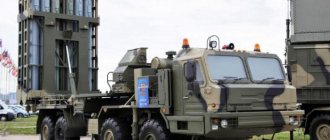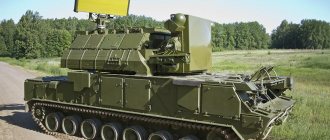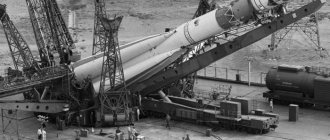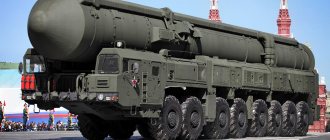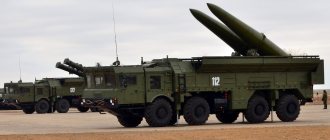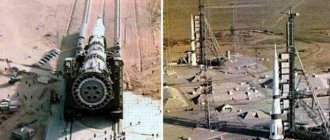R-17 (8K14) "Scud-V" missile of the 9K72 "Elbrus" missile system
This system was designed at the Design Bureau named after. Korolev (OKB-1) and installed on the German A4/V-2. but it was half the size. The first test launch took place on April 18, 1953. Some difficulties arose with the kerosene fuel of the prototype and its leakage; the first version of the missile was known in the USSR as R-11 and 8K11, and in the west the SS-1B Scud-A entered service in July 1955. This missile was classified as an operational-tactical weapon.
R-17 (8K14) missile (Scud-V) - video of a Syrian missile launch
The range of the R-11 missile on the chassis of the IS-2 tank was 180 km, and the power of the atomic charge was 50 kT. The circular probable deviation (CPD) was 3 km. In 1962, an improved version of this model was released, known in the West as the SS-1C "Scud-B", and in the USSR as the R-17 (8K14) 9K72 "Elbrus" missile system. The R-17 had an improved guidance system, using a rudimentary inertial stirrup gyroscope system. The rocket's fuel mixture was improved to include dimethyl hydrazine and red fuming nitric acid. To increase mobility, the system was installed on an eight-wheel MAZ-543P base. In addition to conventional weapons, the missile warhead could be equipped with chemical and nuclear weapons. By 1970, the R-17 missile accounted for 75% of the 300 Scud missiles in service.
Silo missile launcher UR-100N UTTH
Subsequently, the R-17M (9M77) system (SS-1D “Scud-S”) appeared with a lightweight warhead of 600 kg, which is separated when the engine is turned off, and a range of about 550 km. However, it was unclear whether this model had been put into service. The SS-1E Scud-D, designed in the late 1980s, had an improved guidance system that included an active terminal guidance radar, a wide range of warheads and a range of 700 km. The R-11FM was developed as a weapon system for installation on submarines and has been in production since 1955. In September-October 1955, missile tests were carried out in the White Sea from the Project 611 submarine. This missile had a range of 150 km and was approved for naval operations in 1959. The R-11 FM was not used in combat operations. In the USSR, the Scud-B and Scud-S systems were adopted at the army and army group levels in brigades consisting of a headquarters battalion with three firing batteries each, three launchers, stirrup reloading systems each, carrying one missile .
Scud-A and Scud-B were exported to the Warsaw Pact countries, Egypt, Syria, Libya, Iraq and South Yemen, Libya. In 1986, in response to US attacks, Libya fired two Scud B missiles at US Navy installations in Italy. However, the missiles did not hit the target. On January 17, 1991, Iraq launched Scud-B missiles at Tel Aviv. Saddam Hussein used these missiles in response to the unfolding military campaign against the capture of Kuwait. Although the missiles were loaded with conventional charges, the Israelis feared that Iraq, which had already used chemical weapons in its war with Iran, would use something even worse.
Iraq first used Scud-B in the war with Iran to attack Tehran. In 1991, eight Scud missiles exploded in Israel during the first night of the Gulf War. In addition, Iraq launched missile attacks on Saudi Arabia on the first night. By the end of the war, 86 Iraqi Scud missiles had been fired (40 at Israel and 46 at Saudi Arabia). A small number of Iraqi Scud missiles were destroyed during the war, so they still remain potential weapons of mass destruction.
Tactical and technical characteristics of the R-17 (8K14) missile (Scud-V)
| Length | 11.25 m |
| Diameter | 0.88 m |
| Weight | 5900 kg |
| Charge mass | 985 kg |
| Types of charges | atomic 50 kT, high-explosive fragmentation, chemical and educational |
| Minimum range | 80 km |
| Maximum range | 180 km with atomic charge; 300 km with high-explosive or chemical charge |
| Accuracy (QUO) | 450 m at a range of 180 km, decreases with increasing range |
| Launch platform | wheeled transport-launcher MAZ-543P 8x8 |
| Type of fuel | liquid |
R-17 (8K14) (“Scud-V”) photo
Armenia reached “Elbrus”: Yerevan used its most powerful weapon in Karabakh
The war in Nagorno-Karabakh is far from perfect, not only in terms of the operational-tactical art of military leaders, but also in the use of the weapons available to the two sides of the conflict. Given the availability of modern technologies and the latest models of military equipment, both Azerbaijan and Armenia (to a greater extent) use “hardware” produced back in Soviet times, that is, at least 30 years ago, or even more. Yerevan has now launched the Elbrus operational-tactical missile system (OTRK), which ceased production back in 1987.
Two such missiles were launched from the territory of Karabakh quite recently - a video of a paired launch appeared on the Internet, indicating a desire to inflict maximum damage on the enemy with powerful firepower. Previously, at least two more cases of the use of these OTRK by the Armenian army have been reported recently.
The very name of the Elbrus rocket has not just been forgotten; it was, as they say, unheard of before. The R-17 missile with the index 8K14 had a different name, which came from the NATO classification Scud - the world-famous “Scuds”. Soviet rocket scientists among themselves called this liquid-fueled single-stage ballistic missile “kerosene.” And the Elbrus itself is a 9K72 operational-tactical missile system. As is known, Armenia had 8 such complexes at the beginning of the current conflict. And now they have found a use.
Echoes of the Cold War. How an old rocket survived its era
The National Interest believes that the Soviet Elbrus missile system, developed during the Cold War, still remains a very formidable weapon. Despite their age, the missile system and missiles are still found around the world, and their “legacy” still causes problems for Americans.
“One of the most notorious missiles of our time, the short-range ballistic missile Scud (Elbrus according to the Soviet classification - Baltnews note) was developed as a nuclear asset of the Soviet command during the Cold War. Today, more than six decades later, Scud DNA has been found in ballistic missiles from North Korea to Iran.
The magazine's experts note that the Elbrus R-11M missile was developed on the basis of German developments on the V-2 missile and was capable of hitting targets with both conventional and nuclear charges at a range of 100–160 km. The missile and launcher were modernized many times and produced in large quantities
“Military analyst Steven Zaloga estimates the total number of Scud missiles at about 10,000, leaving between five and six thousand by 1997. The total number of launched launch vehicles is estimated at eight hundred. “Scud has been discontinued and is no longer in service with the Russian armed forces,” writes the author of the article.
Despite the fact that the Cold War has become a thing of history, and the Elbrus itself has been removed from service with the Russian army, it continues to remain a formidable weapon in the hands of other countries.
For example, missiles were first used in conflict during the Iran-Iraq War, when Iranian Scuds purchased from Libya were used against Iraqi cities. In turn, Iraq began a program to develop new longer-range missiles based on Elbrus.
The result was the Al-Hussein ballistic missile with a flight range of up to 650 km. Subsequently, Elbrus, as well as its modernized versions, were used many times in the Middle East. Thus, in 1991, Iraq fired about 91 missiles at Israel and Saudi Arabia. Iran may continue to develop its missile program based on these missiles.
Squeal to space. How Russia scared the US this time
Moreover, the publication reports that the Elbrus complexes ended up in North Korea. Some experts are led to such conclusions by the fact that the Elbrus launcher is used almost unchanged in the North Korean army under the name Pukkuksong-2.
“Pyongyang received two Scuds from Egypt between 1976 and 1981. The country's fledgling rocket research enterprise got to work and by 1986 had developed a homemade copy, the Hwasong-5, with an extended range, the article reports.
However, the need to be able to strike US bases in Japan soon brought North Korean missile scientists back to work, and by 1994 they had developed what became known as the Nodong. The Nodonga has a range of 1,500 km, which is enough to strike as far as Okinawa.
"The military spirit is maturing." How rockets are found in the quiet Japanese whirlpool
“The Scud missile, although never fired live during the Cold War for which it was designed, ironically became a major military threat in the post-Cold War era. The missile has since spawned more dangerous missiles and, worse, missile research programs in the hands of rogue states. Although the Scud itself will eventually disappear, its legacy will haunt the world for decades to come,” conclude American experts.
Scud
The 2T3M1 ground trolley based on the ZIL-131V truck tractor with a mock-up of the
R-17 missile, adopted for service in 1962, after it was equipped with missile brigades of the USSR ground forces, the armies of the Warsaw Pact countries and other social. countries, was actively exported in a nuclear-free version (the missile was not supplied to China due to the deterioration of Soviet-Chinese relations). The export R-17 (R-17E or R-300) and its modifications have been repeatedly used in regional conflicts.
The missile programs of North Korea, Pakistan and Iran used R-17 technology to create their medium-range missiles.
Yom Kippur War (1973)
A small number of P-17s were used by Egypt against Israel during the 1973 war.
It was actively used by the Iraqi side to attack Iranian targets.
War in Afghanistan (1979–1989)
More than 2,000 missiles were used by the Soviet army in the Afghan War. After the withdrawal of Soviet troops, the P-17 continued to be used by the Afghan army. On April 20, 1991, three rockets fell on a market in the city of Asadabad, killing about 300 and injuring between 500 and 700 people.[9]
Gulf War (1991)
The ruins of American barracks in Saudi Arabia, after being hit by an Iraqi R-17 missile. The military inspects an unknown type of missile shot down in the desert by the MIM-104 Patriot air defense system during Operation Desert Storm. After the
bombing of an Iraqi nuclear reactor by Israeli aircraft in 1981, a plan was developed in Iraq. "imminent retaliation" in the event of any Israeli invasion. The plan included a strike from western Iraq with Al-Hussein ballistic missiles (modified R-17s). The modification consisted of increasing the missile's flight range to 650 kilometers by reducing the weight of the warhead from 1 ton to 500 kg and, accordingly, reducing accuracy. By early April 1990, the deployment of missiles in western Iraq was completely completed. On July 31, 1990, before the war with Kuwait, the missile units were put on full combat readiness.
The Iraqi Rocket Forces before the Gulf War consisted of the 223rd and 224th Missile Brigades (Al-Hussein, P-17) and the 225th and 226th Brigades (Rad, Luna) under the command of Lieutenant General al-Ayoubi. After the capture of Kuwait, a plan was developed to launch a missile attack on the location of coalition forces in Saudi Arabia. In early December 1990, before the invasion of coalition troops, a training missile launch was carried out.
During the 1991 Gulf War, the Iraqis fired modified P-17s at Israel (43 launches, 40 successful), Saudi Arabia (48 launches, 44 successful), Qatar (1 launch), and Bahrain (1 launch).[10] A total of 93 missiles were launched, 5 missiles went off-trajectory during the start of the launch and 2 during the flight.
Scud missile attacks caused great destruction in Israel and Saudi Arabia (damage amounted to hundreds of millions of dollars). Due to timely warning of rocket attacks, significant casualties were avoided. But in turn, during the shelling, it was stated that the missiles were equipped with chemical weapons, which sowed panic in the cities; many people suffocated in gas masks because they did not know how to use them. However, not a single missile fired was equipped with chemical weapons.
According to the Israeli side, two thirds of the launched missiles fell in uninhabited territory, the economic damage from the destruction amounted to $250 million[11][12]. 1,525 buildings were completely destroyed or seriously damaged and 50 vehicles were destroyed. As a result of rocket attacks on Israeli territory, 4 people were killed and 273 were injured[11][13][14]. As a result of the shelling of Saudi Arabia, several dozen buildings were destroyed, several dozen vehicles were destroyed, 1 person was killed and 65 were injured. Two airfields were also hit (an F-15C fighter and an RC-135V[15] reconnaissance aircraft were damaged by shrapnel). Only one attack had a significant result in terms of the number of casualties: a missile hit the American barracks in the city of Dharam, killing 28 American soldiers and injuring 110[11].
There was a large number of victims from the psychological effect of ballistic missile attacks; in Israel alone, about 70 people died or committed suicide and another 818 required psychological help [ source not specified 715 days
].
A residential building on Uziel Street in Ramat Gan after being hit by an Iraqi R-17 missile.
American Patriot anti-aircraft missile systems were used to repel the attacks, the effectiveness of which there are conflicting statements about. According to Israeli data, no more than 47 P-17s fell into the Patriots’ zones of action, at which a total of 158 interceptor missiles were fired[11]. According to the Israeli Ministry of Defense, the Patriots, despite the overexpenditure of interceptor missiles (including a case with the consumption of 28 units per target[11][ unauthorized source?
]), managed to intercept no more than 20% of the missiles launched by the Iraqis[11]. In other sources, the data varies greatly (from 9% according to estimates of the US Administration Control Chamber[11] to 36% in Russian sources[10], American sources now indicate figures up to 52-80%[16], during the war figures were also given up to 100%[16]). Modern Israeli research suggests that not a single missile was shot down over Israel, and radio reports about one downed R-17 were never confirmed[17]. Such different data are associated with the objective difficulty of assessing the results of firing - even close explosions of the Patriot missile defense system did not destroy the R-17 warheads, but only diverted them from their course[10]. Under these conditions, given the low intrinsic accuracy after the Iraqi “modification” of the R-17 missiles, the criterion for classifying the affected missiles as “downed” is subjective. At the same time, some Patriot missiles fell on residential areas in Israeli cities, causing significant destruction.
The number of Scud mobile missile launchers involved was only 14, another 78 launchers were dummies or decommissioned Luna missiles. Coalition pilots stated that during the war they destroyed about 100 Scuds, but in reality not a single installation was hit, not even a single dummy was damaged. Coalition aircraft managed to bomb only a few empty missile silos. Therefore, the use of R-17 missiles is considered one of the main successes of the Iraqi army in the Gulf War.[18]
Yemeni Civil War (1994)
During the Yemeni Civil War in 1994, both the Democratic Republic of Yemen and government forces used R-17 missiles.[19]
Second Chechen War (1999-2001)
In September 1999, on the basis of the 60th training center for the combat use of missile forces of the ground forces (military unit 42202, Kapustin Yar, site 71), military unit 97211 (630th separate missile division) was formed to participate in hostilities in the Caucasus. , which was armed with the 9K72 missile system[20]. Division commander Lieutenant Colonel Zakharchenko I.I.[20].
The 630th Order was deployed
in the area of the former village of Russkaya on the border with Chechnya, and during the conduct of hostilities in the period from October 1, 1999 to April 15, 2001, made 250 launches of 8K14-1 missiles[21].
The missiles were fired, including expired ones, but not a single failure was recorded. After using up the supply of missiles, the division handed over the equipment to a storage base and in April 2001 was redeployed to the 71st site of the Kapustin Yar training ground[21]. In 2005, the 630th Order
was the first in the Russian Federation to receive the 9K720 Iskander complex.
War between Saudi Arabia and the Houthis in Yemen (2015)
On June 6, 2015, Reuters, citing sources in Saudi Arabia (KSA), reported that Yemeni rebels had launched a Scud missile at a target in KSA. Officially, Riyadh reported that the missile was intercepted by the Patriot air defense system[22]. However, according to French and Iranian sources, that in fact on this day the Houthi rebels managed to launch 12 Scud missiles into Saudi Arabia, and only three of which were shot down by air defense, and the rest either hit their intended targets or fell in a deserted area ; Moreover, during this operation, the chief of the main headquarters of the Saudi Arabian Air Force, Mohammed al-Shaalan, was killed[23].
On June 30, 2015, the Yemen agency SABA reported on the launch of the 9K72E Elbrus OTRK at a target in the KSA. It was reported that the target was successfully hit[24].
On August 26, 2015, a number of sources reported that the Houthis launched “up to three” Scud missiles at targets in Saudi Arabia. Perhaps some of the missiles were intercepted by the Patriot air defense system[25].
Second Karabakh War
According to reports from officials of the Republic of Azerbaijan and independent correspondents, on October 10, 2022, the Armenian side used the Elbrus OTRK against the airfield in the city of Ganja during the Second Karabakh War. The attack hit areas inhabited by civilians. As a result, up to 10 houses were destroyed, 10 were killed and over 40 civilians were injured[26][27]. On October 17, 2022, residential areas of Ganja were hit by another R-17 missile, killing 14 people and injuring 55 people[28][29].
